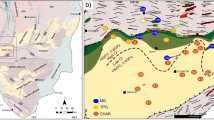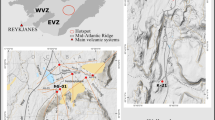Abstract
Knowledge of the rheological properties of the lower crust and the metamorphic processes that operate there is important for our understanding of orogenic processes and granite genesis. The rheological properties critically depend on whether fluids are present in the lower crust1,2 and, if present, on their composition3,4,5,6. Fluid-inclusion7,8,9 and phase-equilibria4,10 studies of lower crustal granulites have shown that fluids with low water activities (due to the presence of dissolved components such as CH4, N2, CO, CO2 and chlorides)11 are present at least episodically in the lower crust. Here we report the occurrence of a solid salt solution (NaCl–KCl) found together with chlorine-rich amphibole and biotite in lower crustal granulites. A desiccation mechanism explains how salt and chlorine-rich minerals formed from an originally water-rich fluid through a short-lived series of hydration reactions in the granulites, during which chlorine was progressively enriched in the fluid. Consequently, it would appear that fluid was present in the lower crust in only small amounts and was not stable over geologically long periods of time, leading to the conclusion that the lower crust is devoid of a free fluid phase during most of its history.
This is a preview of subscription content, access via your institution
Access options
Subscribe to this journal
Receive 51 print issues and online access
$199.00 per year
only $3.90 per issue
Buy this article
- Purchase on Springer Link
- Instant access to full article PDF
Prices may be subject to local taxes which are calculated during checkout




Similar content being viewed by others
References
Frost, R. & Bucher, K. Is water responsible for geophysical anomalies in the deep continental crust? A petrological perspective. Tectonophysics 231, 293–303 (1994).
Jones, A. G. in Continental Lower Crust (eds Fountain, D. M., Arculus, R. & Kay, W.) 81–143 (Developments in Geotectonics 23, Elsevier, Amsterdam, (1992)).
Frost, B. R. & Frost, C. D. CO2, melts and granulite metamorphism. Nature 327, 503–506 (1987).
Valley, J. W., Peterson, E. U. & Essene, E. J. Fluorphlogopite and fluortremolite in Adirondack marbles and calculated C-O-H-F fluid compositions. Am. Mineral. 67, 545–557 (1982).
Valley, J. W., Peterson, E. U. & Essene, E. J. & Lamb, W. Metamorphism in the Adirondacks: II. The role of fluids. J. Petrol. 31, 555–596 (1990).
Newton, R. C., Smith, J. V. & Windley, B. F. Carbonic metamorphism, granulites, and crustal growth. Nature 288, 45–50 (1980).
Philippot, P. & Selverstone, J. Trace-element-rich brines in eclogitic veins: implications for fluid composition and transport during subduction. Contrib. Mineral. Petrol. 106, 417–430 (1991).
Touret, J. L. R. in The Deep Proterozoic Crust in the North Atlantic Provinces (eds Tobi, A. C. & Touret, J. L. R.) 517–550 (Reidel, Dordrecht, Holland, (1985)).
Sciuto, P. F. & Ottonello, G. Water–rock interaction on Zabargad Island, Red Sea — a case study: I. Application of the concept of local equilibrium. Geochim. Cosmochim. Acta 59, 2187–2206 (1995).
Valley, J. W., McLelland, J. & Essene, E. J. Metamorphic fluids in the deep crust: evidence from the Adirondacks. Nature 301, 226–228 (1983).
Wickham, S. M. in Continental Lower Crust (eds Fountain, D. M., Arculus, R. & Kay, W.) 391–421 (Developments in Geotectonics 23, Elsevier, Amsterdam, (1992)).
Griffin, W. L. et al. Archean and Proterozoic crustal evolution in Lofoten-Vesterålen, N. Norway. J. Geol. Soc. Lond. 135, 629–647 (1978).
Markl, G. & Bucher, K. Proterozoic eclogites from the Lofoten Islands, N. Norway. Lithos 42, 15–35 (1997).
Hames, W. E. & Andresen, A. The timing of Paleozoic orogeny and extension in the continental shelf of northcentral Norway as indicated by laser 40Ar/39Ar muscovite dating. Geology 24, 1005–1008 (1996).
Trommsdorf, V., Skippen, G. & Ulmer, P. Halite and sylvite as solid inclusions in high-grade metamorphic rocks. Contrib. Mineral. Petrol. 89, 24–29 (1985).
Kullerud, K. Chlorine, titanium and barium-rich biotites: factors controlling biotite composition and the implications for garnet-biotite geothermometry. Contrib. Mineral. Petrol. 120, 42–59 (1995).
Volfinger, M., Robert, J. & Vielzeuf, D. Structural control of the chlorine content of OH-bearing silicates (micas and amphiboles). Geochim. Cosmochim. Acta 49, 37–48 (1985).
Oberti, R., Ungaretti, L. & Cannillo, E. The mechanism of Cl incorporation in amphibole. Am. Mineral. 78, 746–752 (1993).
Kullerud, K. Chlorine-rich amphiboles: interplay between amphibole composition and an evolving fluid. Eur. J. Mineral. 8, 355–370 (1996).
Munoz, J. L. & Swenson, A. Chloride-hydroxyl exchange in biotite and estimation of relative HCl/HF activities in hydrothermal fluids. Econ. Geol. 76, 2212–2221 (1981).
Aranovich, L. & Newton, R. H2O activity in concentrated NaCl solutions at high pressures and temperatures measured with the brucite-periclase equilibrium. Contrib. Mineral. Petrol. 125, 200–213 (1996).
Zhu, C. & Sverjensky, D. A. Partitioning of F-Cl-OH between minerals and hydrothermal fluids. Geochim. Cosmochim. Acta 55, 1837–1858 (1991).
Aranovich, L. Y. & Newton, R. C. H2O activity in concentrated KCl and KCl–NaCl solutions at high temperatures and pressures measured by the brucite–periclase equilibrium. Contrib. Mineral. Petrol. 127, 261–271 (1997).
Berman, R. G. Mixing properties of Ca-Mg-Fe-Mn garnets. Am. Mineral. 75, 328–344 (1990).
Fuhrmann, M. & Lindsley, D. Ternary-feldspar modeling and thermometry. Am. Mineral. 73, 201–215 (1988).
Chou, I., Sterner, S. M. & Pitzer, K. S. Phase relations in the system NaCl-KCl-H2O:IV. Differential thermal analysis of the sylvite liquidus in the KCl-H2O binary, the liquidus in the NaCl-KCl-H2O ternary, and the solidus in the NaCl-KCl binary to 2kb pressure, and a summary of experimental data for thermodynamic-PTX analysis of solid-liquid equilibria at elevated P-T conditions. Geochim. Cosmochim. Acta 56 2281–2293 (1992).
Nijland, T. G., Jansen, J. B. & Maijer, C. Halogen geochemistry of fluid during amphibolite-granulite metamorphism as indicate by apatite and hydrous silicates in basic rocks from the Bamble Sector, South Norway. Lithos 30, 167–189 (1993).
Henry, D. J. Cl-rich minerals in Archean granulite facies ironstones from the Beartooth Mountains, Montana, USA: Implications for fluids involved in granulite metamorphism. J. Geol. Soc. India 32, 43–45 (1988).
Frost, B. R. & Touret, J. L. R. Magmatic CO2and saline melts from the Sybille Monzosyenite, Laramie Anorthosite Complex, Wyoming. Contrib. Mineral. Petrol. 103, 178–186 (1989).
Lowenstern, J. B. Chlorine, fluid immiscibility, and degassing in peralkaline magmas from Pantelleria, Italy. Am. Mineral. 79, 353–369 (1994).
Enami, M., Liou, J. G. & Bird, D. K. Cl-bearing amphibole in the Salton Sea geothermal system, California. Can. Mineral. 30, 1077–1092 (1992).
Vanko, D. A. Occurrence and origin of marialitic scapolite in the Humboldt Lopolith, N. W. Nevada. Am. Mineral. 71, 51–59 (1986).
Mora, C. I. & Valley, J. W. Halogen-rich scapolite and biotite; Implications of metamorphic fluid-rock interaction. Am. Mineral. 74, 721–737 (1989).
Bennet, D. G. & Barker, A. J. High salinity fluids: The result of retrograde metamorphism in thrust zones. Geochim. Cosmochim. Acta 56, 81–95 (1992).
Acknowledgements
This work greatly benefited from discussions and suggestions of J. Ferry, K. Livi and, in particular, R. Frost, and from the help of H. Müller-Sigmund. Funding of this work by grants from the Deutsche Forschungsgemeinschaft is gratefully acknowledged.
Author information
Authors and Affiliations
Corresponding author
Rights and permissions
About this article
Cite this article
Markl, G., Bucher, K. Composition of fluids in the lower crust inferred from metamorphic salt in lower crustal rocks. Nature 391, 781–783 (1998). https://doi.org/10.1038/35836
Received:
Accepted:
Issue Date:
DOI: https://doi.org/10.1038/35836
This article is cited by
-
Multiphase-solid fluid inclusions in HP-LT eclogite facies rock (Zavkhan Terrane, Western Mongolia): evidence for the evolution from saline to hypersaline fluids during metamorphism in subduction zone
Contributions to Mineralogy and Petrology (2023)
-
The deep Basel-1 geothermal well: an attempt assessing the predrilling hydraulic and hydrochemical conditions in the basement of the Upper Rhine Graben
Swiss Journal of Geosciences (2022)
-
CO2 outgassing during collisional orogeny is facilitated by the generation of immiscible fluids
Communications Earth & Environment (2022)
-
Evaluation of Groundwater Types in Earthquake Observation Wells and Relationship Between Formation Cause and Recharge
Pure and Applied Geophysics (2021)
-
Amphibolite–granulite facies mid-crustal basement in Deccan Large Igneous Province and its implication on Precambrian crustal evolution: evidence from Killari borehole studies
International Journal of Earth Sciences (2021)
Comments
By submitting a comment you agree to abide by our Terms and Community Guidelines. If you find something abusive or that does not comply with our terms or guidelines please flag it as inappropriate.



